The Multi-Channel System of the Vietnamese Mekong Delta: Impacts on the Flow Dynamics under Relative Sea-Level Rise Scenarios
Abstract
:1. Introduction
- Simulating the spatial and temporal distribution of the inundation processes;
- Reevaluating impacts of the multi-channel network on the flow dynamics;
- Forecasting the future patterns of water flux under different scenarios of RSLR in 2050 and 2100.
2. Study Area
3. Model Setup
3.1. TELEMAC 2D
3.2. Data Utilization
- For the estuarine areas (Soai Rap, CuaTieu, Cua Dai and Ham Luong) and the coastal areas of Go Cong, Can Gio and the Ganh Rai Gulf, the topographic data were extracted from the surveying reconnaissance of a 1/5000 scale topographic plane, in the years 2008, 2009 and 2010, under the framework of the Baseline Survey Project implemented by Vietnam’s Southern Institute of Water Resources Research (SIWRR) and the Institute of Coastal and Offshore Engineering (ICOE) as well as survey work package of the Lower Mekong Coastal Delta Zone project (LMCDZ).
- For coastal areas from HCMC to Kien Giang, the topographic data were extracted from the map (scale of 1/100,000) published by the Navy in 1982.
- The topography in other areas of the sea was extracted from the SRTM30_PLUSV6.0 database from the Scripps Institution of Oceanography, Californian University, USA. This is a dataset with a 30″ × 30″ resolution, constructed from the satellite-gravity model, in which the gravity-to-topography ratios are corrected by 298 million ADCP depth points.
3.3. Computational Mesh
3.4. Parameters and Simulation Setup
3.4.1. Boundaries
3.4.2. Parameters of Hydrodynamic Simulation
4. Calibration and Validation
- Hourly data on discharge and water level in Can Tho and My Thuan stations in 2010 and 2011 were collected from the Lower Mekong Coastal Delta Zone project (LMCDZ).
- Hourly data on discharge and water level in Tan Chau and Chau Doc stations in 2010 and 2011 were collected from Vietnam’s National Center for Meteo-Hydrological Forecasting and Vietnam–German University.
- Hourly data on the water level in Vung Tau, Ben Trai, Ganh Hao, Vam Kenh stations in 2010 and 2011 were collected from Vietnam’s National Center for Meteo-Hydrological Forecasting and Vietnam–German University.
5. Results
5.1. Inundation Level and Area
5.2. Flow Velocity
6. Discussion
6.1. Impacts of the Multi-Channel Network
6.1.1. Inundation Level and Area
6.1.2. Water Elevation and Discharge at Can Tho and My Thuan Stations
6.2. Impacts of Sea–Level Rise
6.2.1. Water Elevations and Discharges
6.2.2. Inundation Area
7. Conclusions
Author Contributions
Funding
Acknowledgments
Conflicts of Interest
References
- Wright, L.D. River deltas. In Coastal Sedimentary Environments; Springer: New York, NY, USA, 1978; pp. 5–68. [Google Scholar]
- Bianchi, T.S. Deltas and Humans: A Long Relationship Now Threatened by Global Change; Oxford University Press: Oxford, UK, 2016. [Google Scholar]
- Garschagen, M.; Diez, J.R.; Nhan, D.K.; Kraas, F. Socio-Economic Development in the Mekong Delta: Between the Prospects for Progress and the Realms of Reality. In The Mekong Delta System; Renaud, F., Kuenzer, C., Eds.; Springer Environmental Science and Engineering; Springer: Dordrecht, The Netherlands, 2012. [Google Scholar]
- Best, J. Anthropogenic stresses on the world’s big rivers. Nat. Geosci. 2018, 12, 7–21. [Google Scholar] [CrossRef]
- Kondolf, G.M.; Schmitt, R.J.P.; Carling, P.A.; Goichot, M.; Keskinen, M.; Arias, M.E.; Bizzi, S.; Castelletti, A.; Cochrane, T.A.; Darby, S.E.; et al. Save the Mekong Delta from drowning. Science 2022, 376, 583–585. [Google Scholar] [CrossRef] [PubMed]
- Dung, N.V.; Merz, B.; Bárdossy, A.; Apel, H. Flood hazard in the Mekong Delta—A probabilistic, bivariate, and non-stationary analysis with a short-termed future perspective. Nat. Hazards Earth Syst. Sci. Discuss. 2013, 1, 275–322. [Google Scholar]
- Balica, S.; Dinh, Q.; Popescu, I.; Vo, T.Q.; Pham, D.Q. Flood impact in the MD, Vietnam. J. Maps 2014, 10, 257–268. [Google Scholar] [CrossRef]
- Le, T.V.H.; Nguyen, H.N.; Wolanski, E.; Tran, T.C.; Haruyama, S. The combined impact on the flooding in Vietnam’s Mekong River delta of local man-made structures, sea level rise, and dams upstream in the river catchment. Estuar. Coast. Shelf Sci. 2007, 71, 110–116. [Google Scholar] [CrossRef]
- Västilä, K.; Kummu, M.; Sangmanee, C.; Chinvanno, S. Modelling climate change impacts on the flood pulse in the Lower Mekong floodplains. J. Water Clim. Chang. 2010, 1, 67–86. [Google Scholar] [CrossRef]
- Le Meur, M.; Le Phu, V.; Gratiot, N. What is the future of the lower Mekong basin struggling against human activities? A Review. In River Deltas Research-Recent Advances; IntechOpen: London, UK, 2021. [Google Scholar] [CrossRef]
- Hung, N.N.; Delgado, J.M.; Tri, V.K.; Hung, L.M.; Merz, B.; Bárdossy, A.; Apel, H. Floodplain hydrology of the Mekong Delta, Vietnam. Hydrol. Process. 2012, 26, 674–686. [Google Scholar] [CrossRef]
- Eslami, S.; Hoekstra, P.; Kernkamp, H.; Trung, N.N.; Duc, D.D.; Quang, T.T.; Februarianto, M.; Dam, A.; Vegt, M. Flow Division Dynamics in the Mekong Delta: Application of a 1D-2D Coupled Model. Water 2019, 11, 837. [Google Scholar] [CrossRef]
- Dang, T.D.; Cochrane, T.A.; Arias, M.E.; Van, P.D.T.; de Vries, T.T. Hydrological alterations from water infrastructure development in the Mekong floodplains. Hydrol. Process. 2016, 30, 3824–3838. [Google Scholar] [CrossRef]
- Gugliotta, M.; Saito, Y.; Nguyen, V.L.; Ta, T.K.O.; Nakashima, R.; Tamura, T.; Uehara, K.; Katsuki, K.; Yamamoto, S. Process regime, salinity, morphological, and sedimentary trends along the fluvial to marine transition zone of the mixed-energy Mekong River delta, Vietnam. Cont. Shelf Res. 2017, 147, 7–26. [Google Scholar] [CrossRef]
- Yamazaki, D.; Sato, T.; Kanae, S.; Hirabayashi, Y.; Bates, P.D. Regional flood dynamics in a bifurcating mega delta simulated in a global river model. Geophys. Res. Lett. 2014, 41, 3127–3135. [Google Scholar] [CrossRef]
- Hoa, L.T.V.; Shigeko, H.; Nhan, N.H.; Cong, T.T. Infrastructure effects on floods in the Mekong River Delta in Vietnam. Hydrol. Process. 2008, 22, 1359–1372. [Google Scholar] [CrossRef]
- Duong, T.A.; Hoang, L.P.; Bui, M.D.; Rutschmann, P. Simulating Future Flows and Salinity Intrusion Using Combined One-and Two-Dimensional Hydrodynamic Modelling—The case of Hau River, Vietnamese Mekong Delta. Water 2018, 10, 897. [Google Scholar]
- Dang, T.D.; Cochrane, T.A.; Arias, M.E.; Tri, V.P.D. Future hydrological alterations in the Mekong Delta under the impact of water resources development, land subsidence and sea level rise. J. Hydrol. Reg. Stud. 2018, 15, 119–133. [Google Scholar] [CrossRef]
- Triet, N.V.K.; Dung, N.V.; Fujii, H.; Kummu, M.; Merz, B.; Apel, H. Has dyke development in the Vietnamese Mekong Delta shifted flood hazard downstream? Hydrol. Earth Syst. Sci. 2017, 21, 3991–4010. [Google Scholar] [CrossRef]
- Fujihara, Y.; Hoshikawa, K.; Fujii, H.; Kotera, A.; Nagano, T.; Yokoyama, S. Analysis and attribution of trends in water levels in the Vietnamese Mekong Delta. Hydrol. Process. 2016, 30, 835–845. [Google Scholar] [CrossRef]
- Aires, F.; Venot, J.-P.; Massuel, S.; Gratiot, N.; Pham-Duc, B.; Prigent, C. Surface water evolution (2001–2017) at the Cambodia/Vietnam border in the Upper Mekong Delta using satellite MODIS observations. Remote Sens. 2020, 12, 800. [Google Scholar] [CrossRef]
- Minderhoud, P.S.J.; Coumou, L.; Erkens, G.; Middelkoop, H.; Stouthamer, E. Mekong delta much lower than previously assumed in sea-level rise impact assessments. Nat. Commun. 2019, 10, 3847. [Google Scholar] [CrossRef]
- Smajgl, A.; Toan, T.Q.; Nhan, D.K.; Ward, J.; Trung, N.H.; Tri, L.Q.; Tri, V.P.D.; Vu, P.T. Responding to rising sea levels in the Mekong Delta. Nat. Clim. Chang. 2015, 5, 167–174. [Google Scholar] [CrossRef]
- Marchesiello, P.; Kestenare, E.; Almar, R.; Boucharel, J.; Nguyen, N.M. Longshore drift produced by climate-modulated monsoons and typhoons in the South China Sea. J. Mar. Syst. 2020, 211, 103399. [Google Scholar] [CrossRef]
- Nguyen, T.C.; Schwarzer, K.; Ricklefs, K. Water-level changes and subsidence rates along the Saigon-Dong Nai River Estuary and the East Sea coastline of the Mekong Delta. Estuar. Coast. Shelf Sci. 2023, 283, 108259. [Google Scholar] [CrossRef]
- Tessler, Z.D.; Vörösmarty, C.J.; Overeem, I.; Syvitski, J.P. A model of water and sediment balance as determinants of relative sea level rise in contemporary and future deltas. Geomorphology 2018, 305, 209–220. [Google Scholar] [CrossRef]
- Nguyen, T.T.; Dong-Sin, S.; Chua, L.H.; Nguyen, L.H.; Ha, L.H.; Ngo, A.T.; Luu, N.V.; Huynh, T.V.; Duong, L.M.; Tran, C.N. Revealing riverbed morphological evolution in river system with complexity: The Vietnam Mekong River case study. J. Hydrol. 2023, 617, 128897. [Google Scholar] [CrossRef]
- Manh, N.V.; Dung, N.V.; Hung, N.N.; Merz, B.; Apel, H. Large-scale quantification of suspended sediment transport and deposition in the Mekong Delta. Hydrol. Earth Syst. Sci. Discuss. 2014, 11, 4. [Google Scholar]
- TELEMAC—2D User Manual. Available online: http://www.opentelemac.org/index.php/manuals (accessed on 18 January 2020).
- Darby, S.E.; Hackney, C.R.; Leyland, J.; Kummu, M.; Lauri, H.; Parsons, D.R.; Best, J.L.; Nicholas, A.P.; Aalto, R. Fluvial sediment supply to a mega-delta reduced by shifting tropical-cyclone activity. Nature 2016, 539, 276–279. [Google Scholar] [CrossRef] [PubMed]
- Wolanski, E.; Huan, N.N.; Dao, L.T.; Nhan, N.H.; Thuy, N.N. Fine-sediment Dynamics in the Mekong River Estuary, Vietnam. Estuar. Coast. Shelf Sci. 1996, 43, 565–582. [Google Scholar] [CrossRef]
- Eslami, S.; Hoekstra, P.; Trung, N.N.; Kantoush, S.A.; Van Binh, D.; Dung, D.D.; Quang, T.T.; van der Vegt, M. Tidal amplification and salt intrusion in the Mekong Delta driven by anthropogenic sediment starvation. Sci. Rep. 2019, 9, 18746. [Google Scholar] [CrossRef]
- Anthony, E.J.; Brunier, G.; Besset, M.; Goichot, M.; Dussouillez, P.; Nguyen, V.L. Linking rapid erosion of the Mekong River delta to human activities. Sci. Rep. 2015, 5, 14745. [Google Scholar] [CrossRef]
- Marchesiello, P.; Nguyen, N.M.; Gratiot, N.; Loisel, H.; Anthony, E.J.; Dinh, C.S.; Nguyen, T.; Almar, R.; Kestenare, E. Erosion of the coastal Mekong delta: Assessing natural against man induced processes. Cont. Shelf Res. 2019, 181, 72–89. [Google Scholar] [CrossRef]
- Erban, L.E.; Gorelick, S.M.; A Zebker, H. Groundwater extraction, land subsidence, and sea-level rise in the Mekong Delta, Vietnam. Environ. Res. Lett. 2014, 9, 084010. [Google Scholar] [CrossRef]
- Wassmann, R.; Hien, N.X.; Hoanh, C.T.; Tuong, T.P. Sea level rise affecting the Vietnamese Mekong Delta: Water elevation in the flood season and implications for rice production. Clim. Change 2004, 66, 89–107. [Google Scholar] [CrossRef]
- Van, P.D.T.; Popescu, I.; van Griensven, A.; Solomatine, D.P.; Trung, N.H.; Green, A. A study of the climate change impacts on fluvial flood propagation in the Vietnamese Mekong Delta. Hydrol. Earth Syst. Sci. 2012, 16, 4637–4649. [Google Scholar] [CrossRef]
- Triet, N.V.K.; Dung, N.V.; Hoang, L.P.; Le Duy, N.; Tran, D.D.; Anh, T.T.; Kummu, M.; Merz, B.; Apel, H. Future projections of flood dynamics in the Vietnamese Mekong Delta. Sci. Total Environ. 2020, 742, 140596. [Google Scholar] [CrossRef] [PubMed]
- MONRE. Climate Change and Sea Level Rise Scenarios for Vietnam; Ministry of Natural Resources and Environment: Hanoi, Vietnam, 2016. Available online: http://chuyentrang.monre.gov.vn/upload/13376/fck/files/KBBDKH_2016.pdf (accessed on 18 January 2020). (In Vietnamese)
- Tri, V.K. Hydrology and hydraulic infrastructure systems in the Mekong Delta, Vietnam. In The Mekong Delta System: Interdisciplinary Analyses of a River Delta; Springer: Dordrecht, The Netherlands, 2012; pp. 49–81. [Google Scholar]
- Zoccarato, C.; Minderhoud, P.S.J.; Teatini, P. The role of sedimentation and natural compaction in a prograding delta: Insights from the mega Mekong delta, Vietnam. Sci. Rep. 2018, 8, 11437. [Google Scholar] [CrossRef]
- Renaud, F.G.; Kuenzer, C. (Eds.) The Mekong Delta System: Interdisciplinary Analyses of a River Delta; Springer Science & Business Media: Berlin/Heidelberg, Germany, 2012. [Google Scholar]
- Käkönen, M. Mekong Delta at the crossroads: More control or adaptation? AMBIO 2008, 37, 205–212. [Google Scholar] [CrossRef]
- Simon, B. Extending the Hydraulic Paradigm: Reunification, state consolidation, and water control in the Vietnamese Mekong Delta after 1975. Southeast Asian Stud. 2014, 3, 547–587. [Google Scholar]
- Hoanh, C.T.; Suhardiman, D.; Anh, L.T. Irrigation development in the Vietnamese Mekong Delta: Towards polycentric water governance? Int. J. Water Gov. 2014, 2, 61–82. [Google Scholar] [CrossRef]
- Van Binh, D.; Kantoush, S.A.; Saber, M.; Mai, N.P.; Maskey, S.; Phong, D.T.; Sumi, T. Long-term alterations of flow regimes of the Mekong River and adaptation strategies for the Vietnamese Mekong Delta. J. Hydrol. Reg. Stud. 2020, 32, 100742. [Google Scholar] [CrossRef]
- Dang, T.D. The Effect of Water Infrastructure Development on Flow Regimes and Sedimentation in the Mekong Floodplains. Ph.D. Thesis, University of Canterbury, Christchurch, New Zealand, 2018. Available online: https://ir.canterbury.ac.nz/items/57211b42-2f7a-4384-bb53-bc076dca1dfa (accessed on 18 January 2020).
- MRC. Overview of the Hydrology of the Mekong Basin, Tech; MRC: Vientiane, Laos, 2005; Available online: http://www.mekonginfo.org/assets/midocs/0001968-inland-waters-overview-of-the-hydrology-of-the-mekong-basin.pdf (accessed on 18 January 2020).
- Eastham, J.; Mpelasoka, F.; Mainuddin, M.; Ticehurst, C.; Dyce, P.; Hodgson, G.; Ali, R.; Kirby, M. Mekong River Basin Water Resources Assessment: Impacts of Climate Change. In Water for a Healthy Country National Research Flagship; CSIRO: Canberra, Australia, 2008. [Google Scholar]
- Hapuarachchi, H.A.P.; Takeuchi, K.; Zhou, M.; Kiem, A.S.; Georgievski, M.; Magome, J.; Ishidaira, H. Investigation of the Mekong River basin hydrology for 1980–2000 using the YHyM. Hydrol. Process. 2008, 22, 1246–1256. [Google Scholar] [CrossRef]
- Vu, T.; Nguyen, P.; Chua, L.; Law, A. Two-dimensional hydrodynamic modelling of flood inundation for a part of the Mekong River with TELEMAC-2D. Br. J. Environ. Clim. Chang. 2015, 5, 162–175. [Google Scholar] [CrossRef]
- Pelckmans, I.; Gourgue, O.; Belliard, J.P.; Dominguez-Granda, L.E.; Slobbe, C.; Temmerman, S. Hydrodynamic modelling of the tide propagation in a tropical delta: Overcoming the challenges of data scarcity. In Proceedings of the TELEMAC User Conference, Antwerp, Belgium, 15–16 October 2020; pp. 34–39. [Google Scholar]
- Haque, M.; Seidou, O.; Mohammadian, A.; Ba, K. Effect of rating curve hysteresis on flood extent simulation with a 2D hydrodynamic model: A case study of the Inner Niger Delta, Mali, West Africa. J. Afr. Earth Sci. 2021, 178, 104187. [Google Scholar] [CrossRef]
- Pérez-Ortiz, A.; Pescatore, J.; Bryden, I. A systematic approach to undertake tidal energy resource assessment with Telemac-2D. In Proceedings of the 10th European Wave and Tidal Energy Conference (EWTEC), Aalborg, Denmark, 2–5 September 2013; p. 9. [Google Scholar]
- Nikuradse, J. Laws of Flow in Rough Pipes; National Advisory Committee for Aeronautics: Washington, DC, USA, 1950; p. 1292.
- Tassi, P.; Villaret, C. Sisyphe v6. 3 User’s Manual; Recherche et Développement, Électricité de France: Chatou, France, 2014. [Google Scholar]
- Julien, P.Y. Erosion and Sedimentation; Cambridge University Press: Cambridge, UK, 2010. [Google Scholar]
- Takagi, H.; Thao, N.D.; Esteban, M. Tropical cyclones and storm surges in Southern Vietnam. In Coastal Disasters and Climate Change in Vietnam; Elsevier: Amsterdam, The Netherlands, 2014; pp. 3–16. [Google Scholar]
- Chen, X.; Liu, H.; Mu, X. Summary of Flood and Drought in Mekong River Basin. In Flood Prevention and Drought Relief in Mekong River Basin; Springer: Singapore, 2020; pp. 27–54. [Google Scholar]
- Nash, J.E.; Sutcliffe, J.V. River flow forecasting through conceptual models part I—A discussion of principles. J. Hydrol. 1970, 10, 282–290. [Google Scholar] [CrossRef]
- Brunier, G.; Anthony, E.J.; Goichot, M.; Provansal, M.; Dussouillez, P. Recent morphological changes in the Mekong and Bassac river channels, Mekong delta: The marked impact of river-bed mining and implications for delta destabilisation. Geomorphology 2014, 224, 177–191. [Google Scholar] [CrossRef]
- Hackney, C.R.; Darby, S.E.; Parsons, D.R.; Leyland, J.; Best, J.L.; Aalto, R.; Nicholas, A.P.; Houseago, R.C. River bank instability from unsustainable sand mining in the lower Mekong River. Nat. Sustain. 2020, 3, 217–225. [Google Scholar] [CrossRef]
- Minderhoud, P.; Coumou, L.; Erban, L.; Middelkoop, H.; Stouthamer, E.; Addink, E. The relation between land use and subsidence in the Vietnamese Mekong delta. Sci. Total Environ. 2018, 634, 715–726. [Google Scholar] [CrossRef]
- Apel, H.; Trepat, O.M.; Hung, N.N.; Chinh, D.T.; Merz, B.; Dung, N.V. Combined fluvial and pluvial urban flood hazard analysis: Concept development and application to Can Tho city, Mekong Delta, Vietnam. Nat. Hazards Earth Syst. Sci. 2016, 16, 941–961. [Google Scholar] [CrossRef]
- Hoang, L.P.; Lauri, H.; Kummu, M.; Koponen, J.; van Vliet, M.T.; Supit, I.; Leemans, R.; Kabat, P.; Ludwig, F. Mekong River flow and hydrological extremes under climate change. Hydrol. Earth Syst. Sci. 2016, 20, 3027–3041. [Google Scholar] [CrossRef]
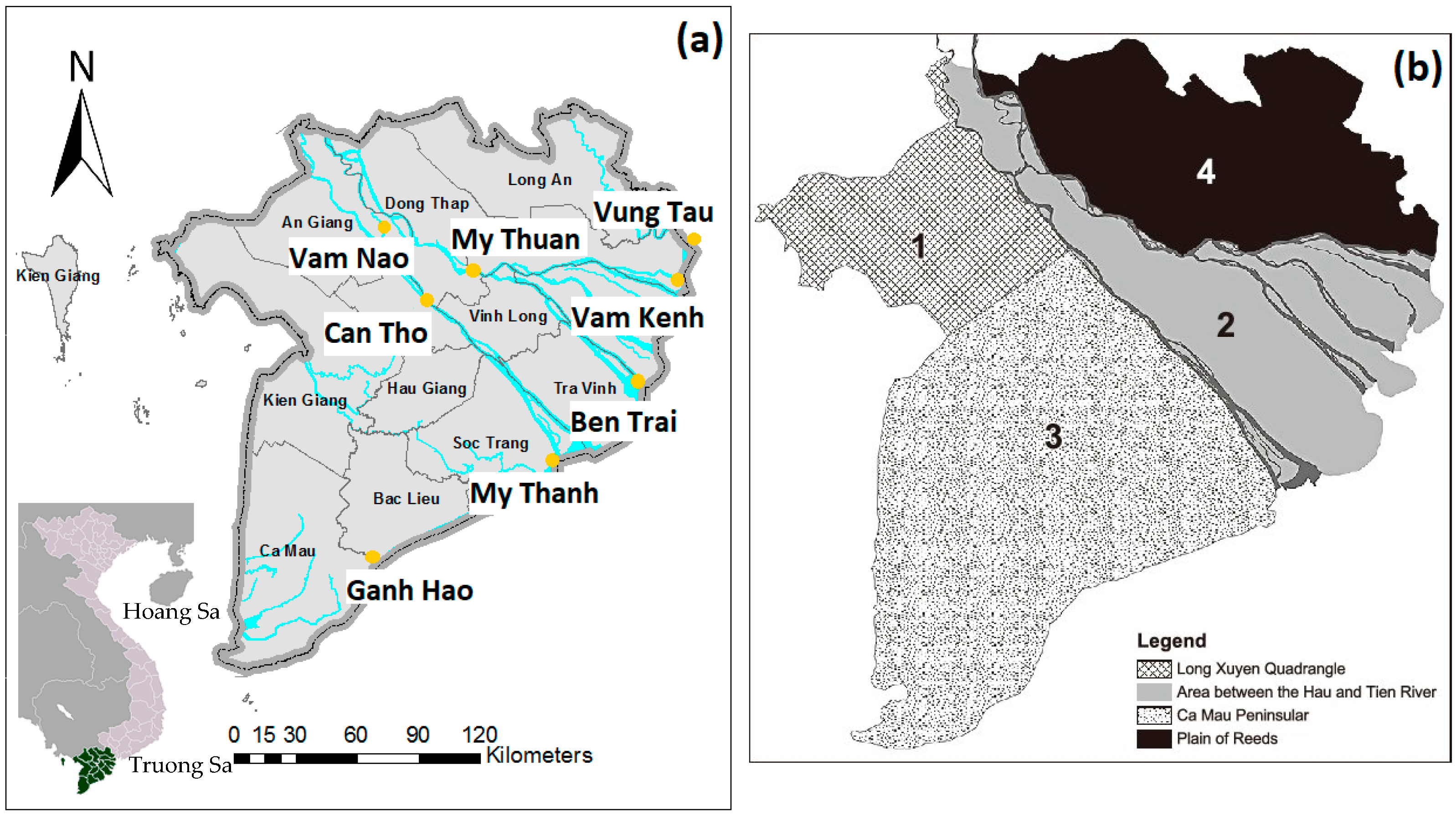

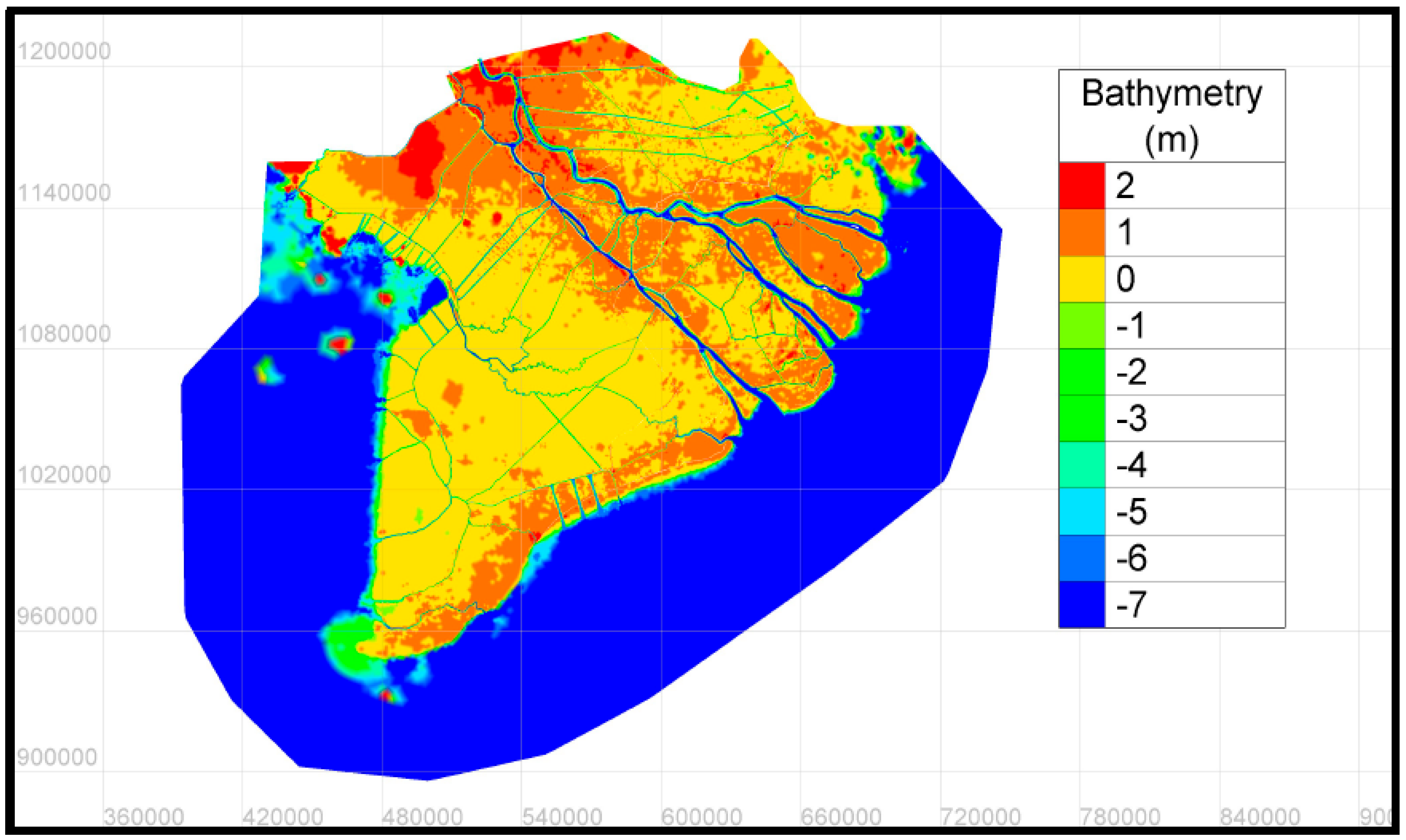
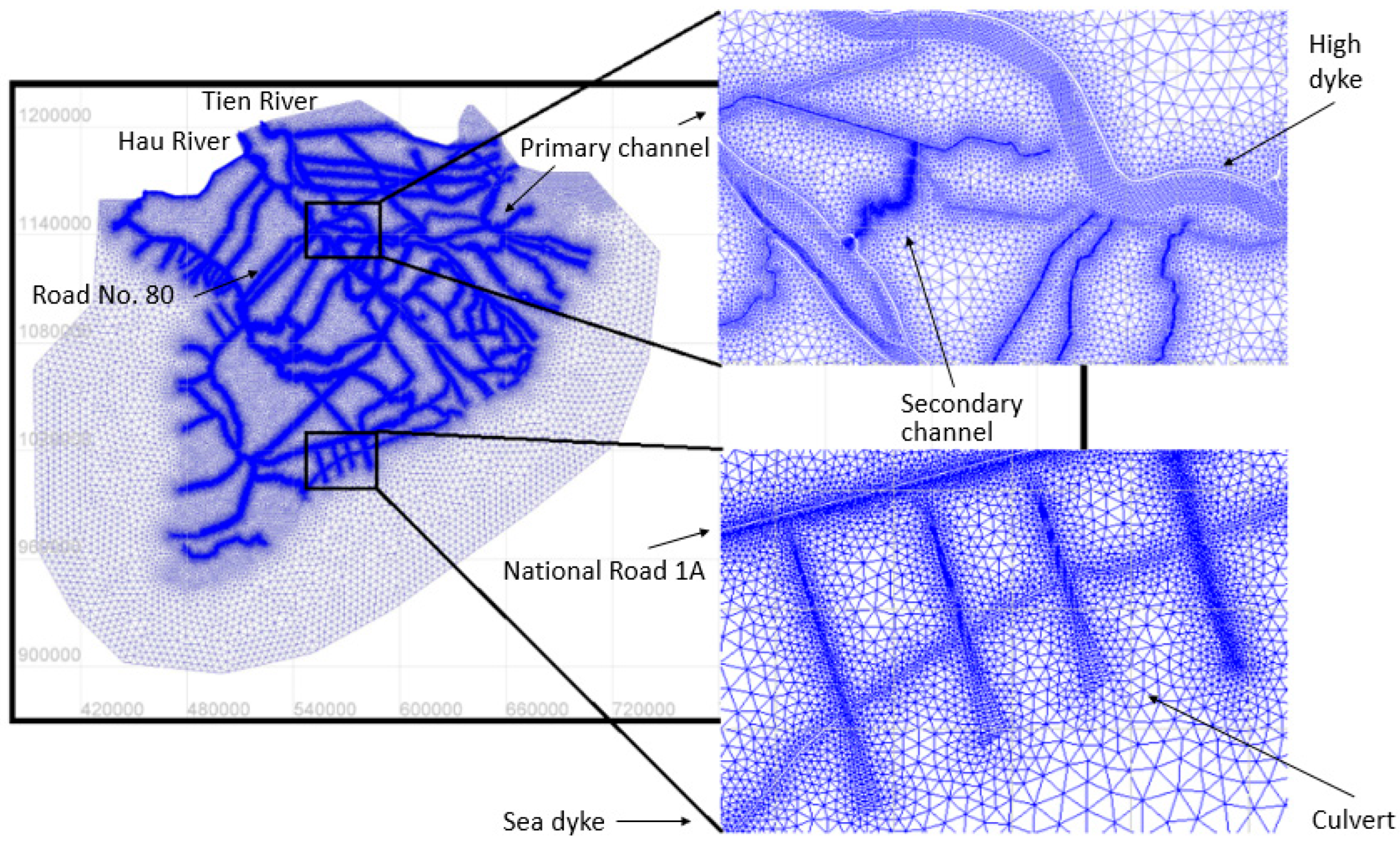


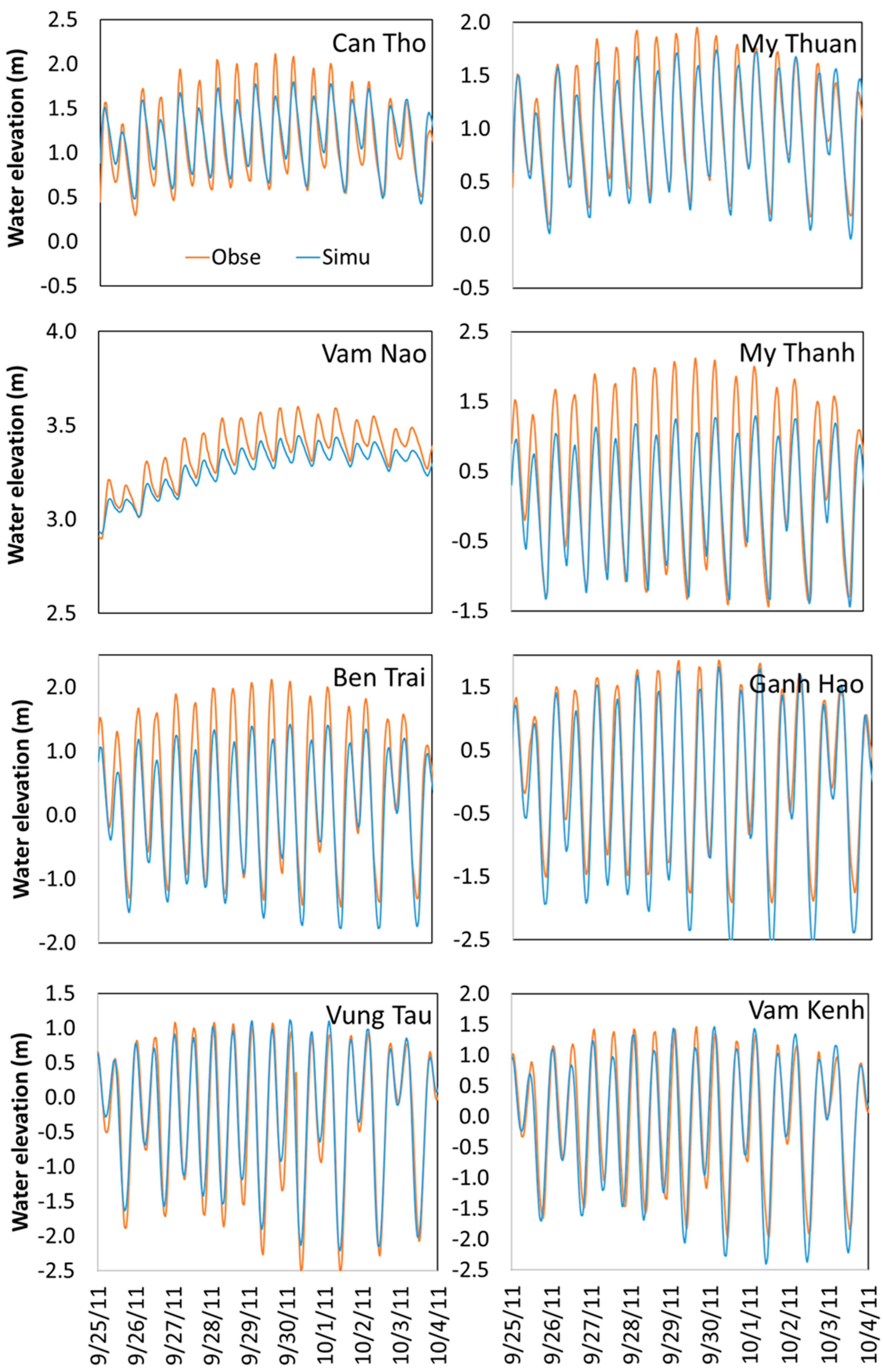
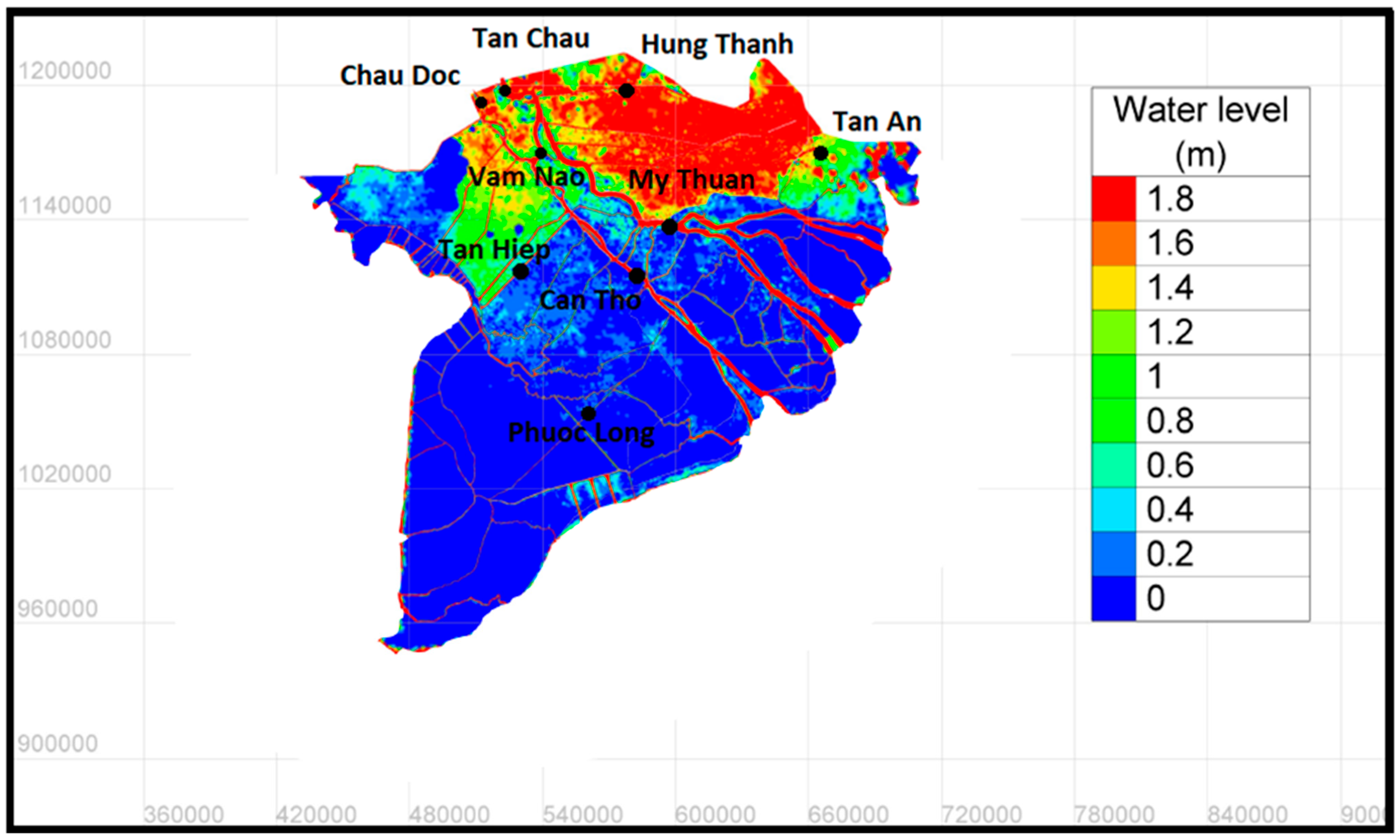
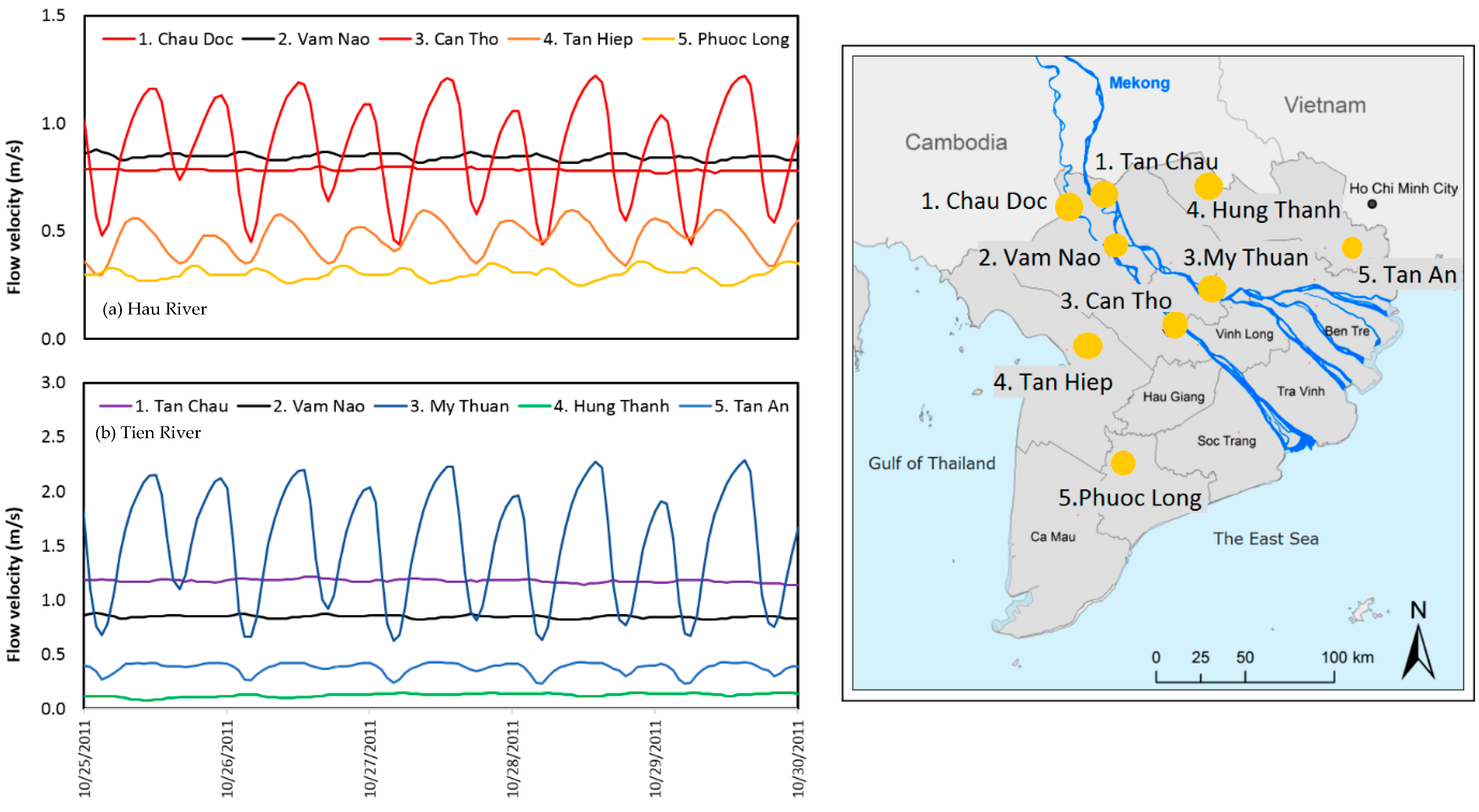
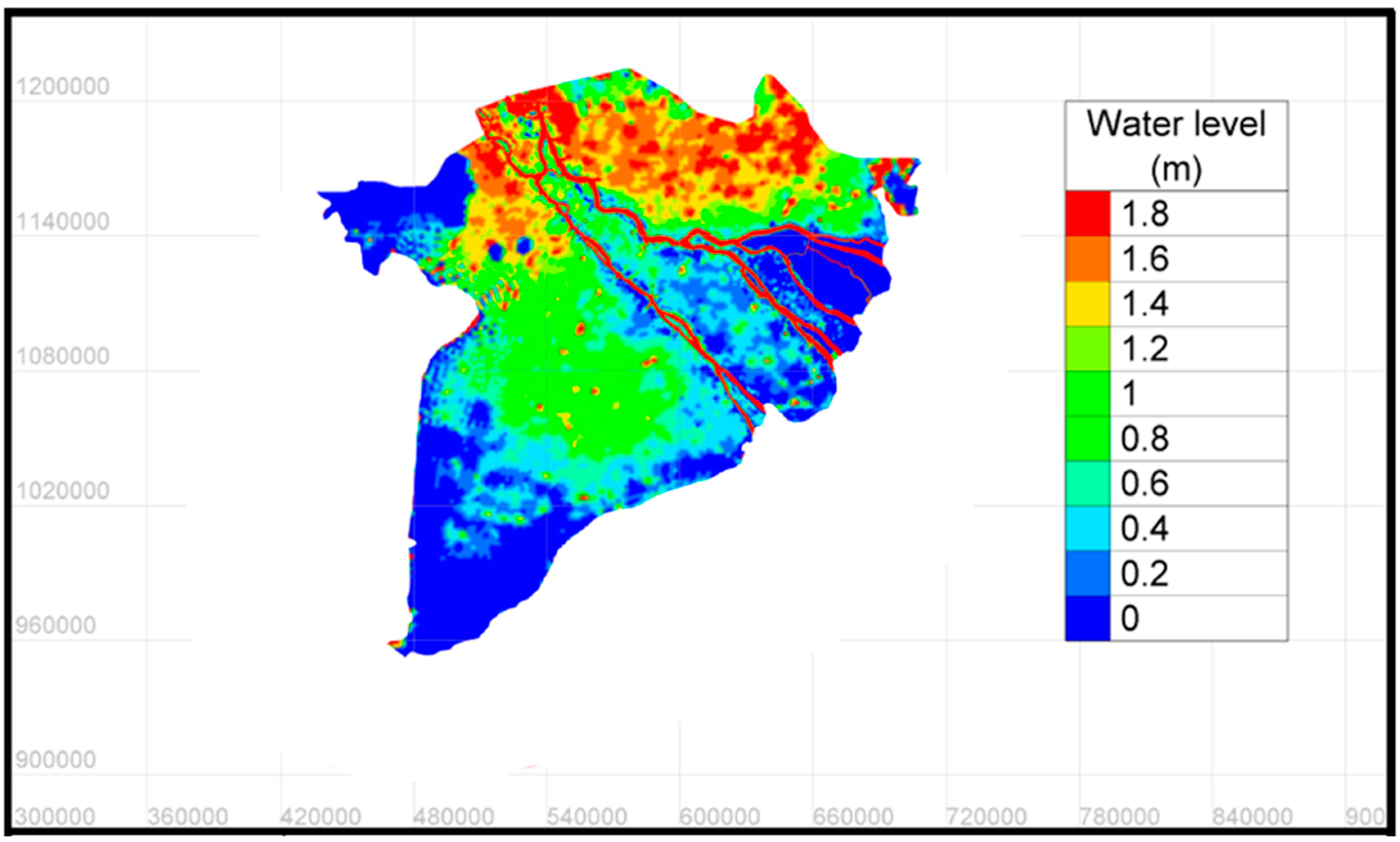

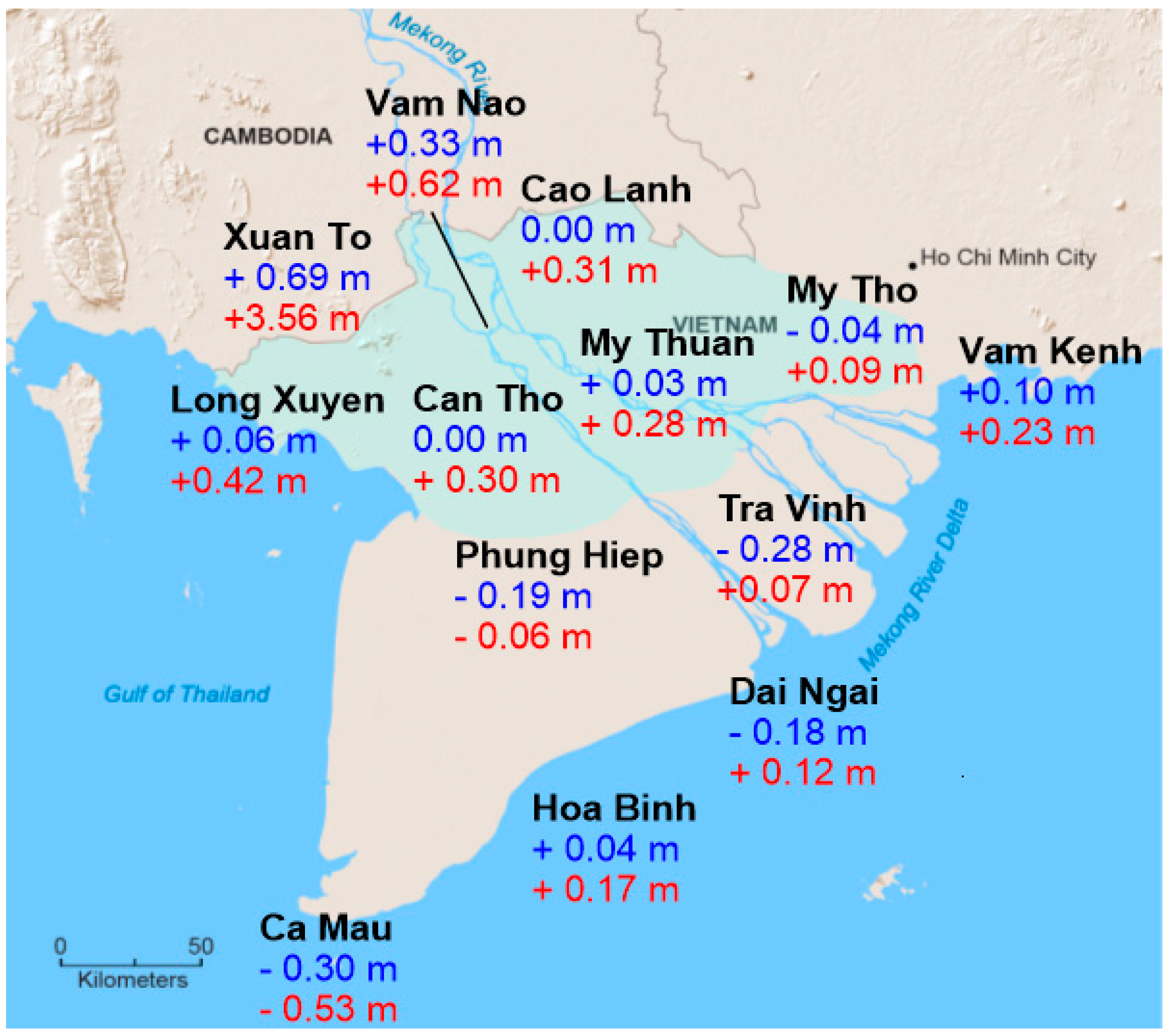


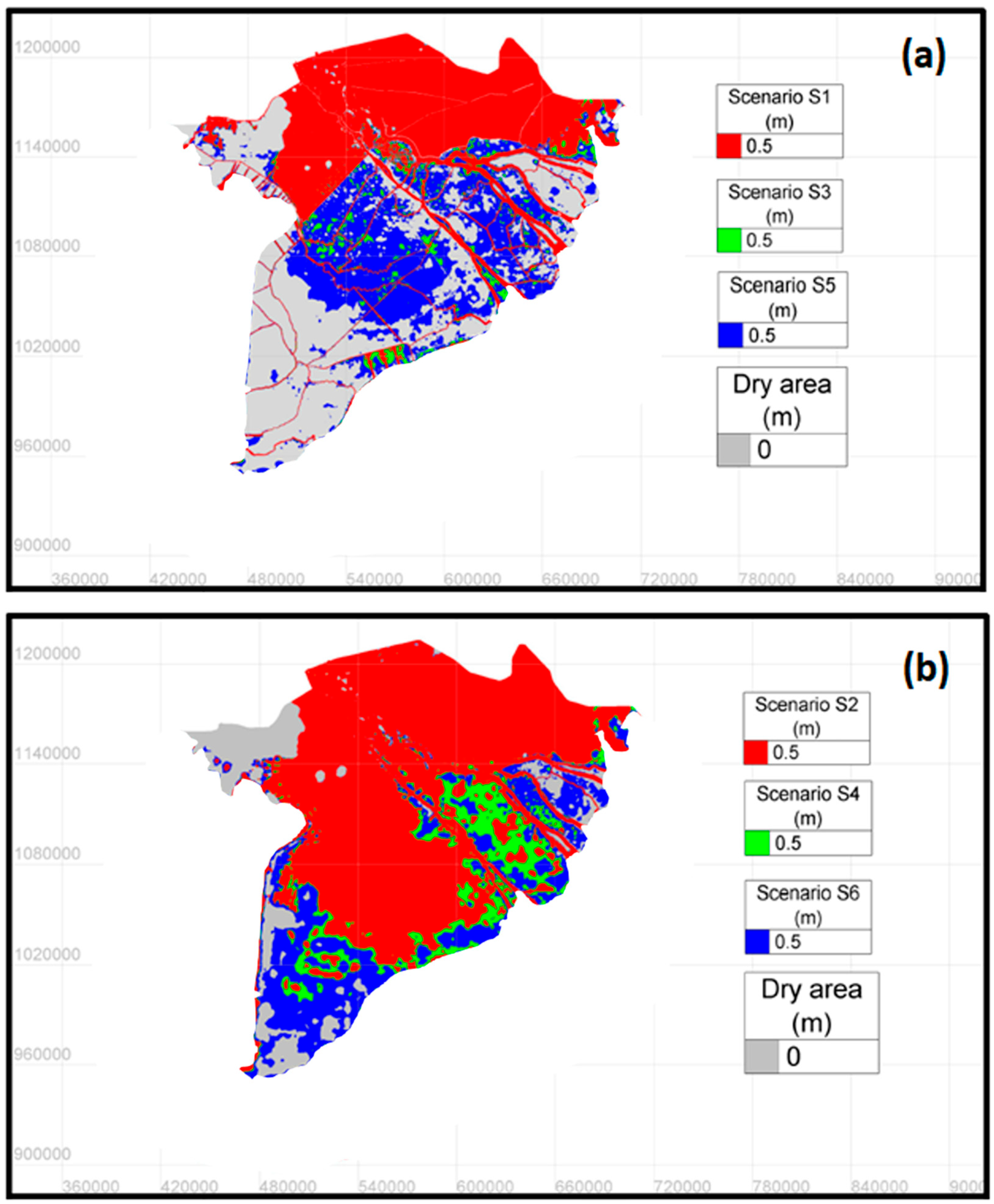
| Data Type | Frequency | Data Source |
|---|---|---|
| River network and channel cross-sections | Surveyed from 1995 to 2000 with updates between 2005 and 2010 | HoChiMinh city University of Technology, Vietnam Southern Institute for Water Resources Research, Vietnam MRC |
| Hydraulic infrastructure operations | Hydraulic infrastructure embedded in the model are based on official regulations for 2010–2011 | |
| Hydrological data | Can Tho and My Thuan (hourly Q and H in 2010 and 2011) | Lower Mekong Coastal Delta Zone project |
| Tan Chau and Chau Doc (hourly Q and H) in 2010 and 2011 Vung Tau, Ben Trai, Ganh Hao, Vam Kenh (hourly H) in 2010 and 2011 | National Center for Meteo-Hydrological forecasting, Vietnam Vietnam–German University | |
| Offshore wind | The hourly wind data at 10 m | NCEP NOAA |
| Offshore tidal constituents | Amplitude and phase of tidal constituents | TPXO 8.0 |
| Scenario | Description |
|---|---|
| S1 | Two main rivers and the multi-channel network, as the current status of the VMD |
| S2 | Two main rivers without the multi-channel network, as representative of the delta situation prevailing before the construction of the dykes and channels |
| S3 | Same as Scenario S1 with a projected RSLR of 30 cm |
| S4 | Same as Scenario S2 with a projected RSLR of 30 cm |
| S5 | Same as Scenario S1 with a projected RSLR of 100 cm |
| S6 | Same as Scenario S2 with a projected RSLR of 100 cm |
| No. | Subdomain | Nikuradse Roughness (m) | No. | Subdomain | Nikuradse Roughness (m) |
|---|---|---|---|---|---|
| 1 | Tien river | 0.1 | 4 | Co Chien estuary | 0.01 |
| 2 | Hau river | 0.12 | 5 | Ham Luong estuary | 0.01 |
| 3 | Vam Nao conjunction | 0.1 | 6 | The remaining area | 0.1 |
| No. | Station | Calibration 10–19 September 2011 | Validation 25 September–4 October 2011 | ||||
|---|---|---|---|---|---|---|---|
| NSE (%) | MAE (m) | RMSE (m) | NSE (%) | MAE (m) | RMSE (m) | ||
| 1 | Can Tho | 74.69 | 0.178 | 0.203 | 87.48 | 0.136 | 0.163 |
| 2 | My Thuan | 82.95 | 0.830 | 0.273 | 92.52 | 1.116 | 0.303 |
| 3 | Vam Nao | 74.04 | 0.004 | 0.131 | 60.29 | 0.008 | 0.143 |
| 4 | My Thanh | 87.14 | 0.263 | 0.316 | 76.99 | 0.391 | 0.487 |
| 5 | Ben Trai | 79.98 | 0.249 | 0.292 | 82.16 | 0.360 | 0.429 |
| 6 | Ganh Hao | 90.83 | 1.472 | 0.272 | 88.49 | 1.726 | 0.366 |
| 7 | Vung Tau | 87.26 | 0.225 | 0.275 | 93.04 | 0.192 | 0.249 |
| 8 | Vam Kenh | 92.97 | 0.175 | 0.211 | 84.96 | 0.292 | 0.365 |
| Parameter | S1 | S2 | S3 | S4 | S5 | S6 |
|---|---|---|---|---|---|---|
| Max. water level at Can Tho (m) | 1.68 | 2.09 | 1.96 | 2.33 | 2.23 | 2.56 |
| Max. water level at My Thuan (m) | 1.62 | 1.87 | 1.91 | 2.17 | 2.17 | 2.50 |
| Max. discharge at Can Tho (m3/s) | 20,396 | 22,358 | 26,400 | 26,888 | 27,875 | 28,424 |
| Max. discharge at My Thuan (m3/s) | 18,348 | 23,765 | 25,192 | 26,750 | 27,624 | 29,183 |
| Inundation area (km2) | 11,710 | 25,918 | 12,750 | 27,617 | 20,385 | 34,199 |
| Percentage in the VMD | 29% | 65% | 32% | 69% | 51% | 85% |
Disclaimer/Publisher’s Note: The statements, opinions and data contained in all publications are solely those of the individual author(s) and contributor(s) and not of MDPI and/or the editor(s). MDPI and/or the editor(s) disclaim responsibility for any injury to people or property resulting from any ideas, methods, instructions or products referred to in the content. |
© 2023 by the authors. Licensee MDPI, Basel, Switzerland. This article is an open access article distributed under the terms and conditions of the Creative Commons Attribution (CC BY) license (https://creativecommons.org/licenses/by/4.0/).
Share and Cite
Le, H.-A.; Nguyen, T.; Gratiot, N.; Deleersnijder, E.; Soares-Frazão, S. The Multi-Channel System of the Vietnamese Mekong Delta: Impacts on the Flow Dynamics under Relative Sea-Level Rise Scenarios. Water 2023, 15, 3597. https://doi.org/10.3390/w15203597
Le H-A, Nguyen T, Gratiot N, Deleersnijder E, Soares-Frazão S. The Multi-Channel System of the Vietnamese Mekong Delta: Impacts on the Flow Dynamics under Relative Sea-Level Rise Scenarios. Water. 2023; 15(20):3597. https://doi.org/10.3390/w15203597
Chicago/Turabian StyleLe, Hoang-Anh, Thong Nguyen, Nicolas Gratiot, Eric Deleersnijder, and Sandra Soares-Frazão. 2023. "The Multi-Channel System of the Vietnamese Mekong Delta: Impacts on the Flow Dynamics under Relative Sea-Level Rise Scenarios" Water 15, no. 20: 3597. https://doi.org/10.3390/w15203597






